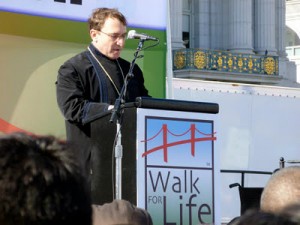
Annually, all over the country thousands of pro-lifers gather together at Walk for Life to raise money and awareness for local pregnancy centers. The event is similar to the American Cancer Society's annual Relay for Life with games, carnival blow-ups and of course, food. Unfortunately, it is only during the day. No overnight partying here.
The original Walk for Life occurred back in 2005 on the streets of San Francisco in protest of the city that held the controversial and revolutionary trial of Roe v. Wade. In the last seven years, the Walk for Life movement has spread through churches, synagogues and other organizations in support of helping women care for a child who they otherwise would be forced to abort. Those involved in the Walk movement take a very different approach to the in-your-face post-abortion fetus poster waving anti-abortion advocates found in parks and the center of college campuses. Instead of pressing the women into a decision, they educate the women about the options and consequences of the procedure and offer assistance in whatever the woman's choice is. Since those involved in Walk for Life tend to come from nearby religious centers, they fight for their beliefs through awareness and love. The only conflict they usually seem to have is with traffic as police escorts hold it off so the demonstrators can cross the street.

Though, there has been a little friction between Walk for Life and those who uphold Roe v. Wade and a woman's right to choose. In San Francisco, small groups of protestors would counter-protest on the streets as the throngs of walkers pass by. In recent years, the level of conflict has dropped, probably due to the lack of retaliation by those participating in the walk. A rather bizarre incident broke out in Washington D.C. this past January. The first ever Walk for Life Youth Rally was interrupted by pro-choice protestors who stood up in the middle of Rev. Pat Mahoney's speech. The students did not react in anger to these disrupters but instead actually began to silently pray for them while waiting for security to arrive. Later Rev. Pay Mahoney shared his opinion of the youth and was proud that they acted well in response to the hateful chants of "pro-life, that's a life, you don't care if women die!" the mere 20 protestors. Mahoney also commented on how he felt that so few of the protestors showed the success of the movement. He believed this really showed how pro-life America was becoming.
Mahoney's statement may be a little on the hopeful side, but Nellie Gray's pro-life organization does it's job very well. Walk for Life raises money with pledges by allowing local businesses to advertise. Most of their money comes from the walker's themselves who raise money on their own time. Those who reach a certain quota in their donation get rewarded with something simple like a T-shirt, or if they hit the couple thousand mark, receive some fancy gadgets like a High-Definition TV.
Regardless of the motivating prizes for raising money, some simply come out to support the pregnancy centers. Spectators know that their reward is in improving a woman's life by giving her the gift of the chance to more easily raise a child that she couldn't have done without their help.
The ninth annual Walk for Life will be held on January 26, 2013 in San Francisco, California.
